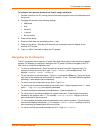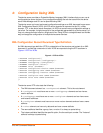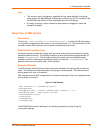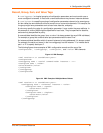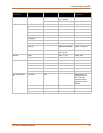
4: Configuration Using XML
EDS-MD Command Reference 16
Record, Group, Item, and Value Tags
A <configgroup> is a logical grouping of configuration parameters and must contain one or
more <configitem> elements. It must have a name attribute and may have an instance attribute.
A <configitem> is a specific grouping of configuration parameters relevant to its parent group.
An item takes the name attribute and must contain one or more value elements. For example, the
line group might have parameters such as baud rate, data bits, and parity.
A value may specify the value of a configuration parameter. It may contain the name attribute. In
this example, a value of 9600 might be specified for baud rate; 7 may be specified for data bits,
and even may be specified for parity.
A name attribute identifies the group, item, or value. It is always quoted (as are all XML attributes).
For example, a group that contains serial port parameters has the name "line".
An instance attribute identifies which of several instances is being addressed. It is always quoted.
For example, the serial port name (in the line configgroup) has the instance "1" to indicate serial
port 1 or "2" to specify serial port 2.
The following figures show examples of XML configuration records and the use of the
<configrecord>, <configgroup>, <configitem>, and <value> XML elements.
Figure 4-3 XML Example
<?xml version="1.0" standalone="yes"?>
<configrecord>
<configgroup name = "serial command mode" instance = "1">
<configitem name = "mode">
<value>disable</value>
</configitem>
</configgroup>
</configrecord>
Figure 4-4 XML Example of Multiple Named Values
<?xml version="1.0" standalone="yes"?>
<configgroup name = "ethernet" instance = "eth0">
<configitem name = "speed">
<value>Auto</value>
</configitem>
<configitem name = "duplex">
<value>Auto</value>
</configitem>
</configgroup>





